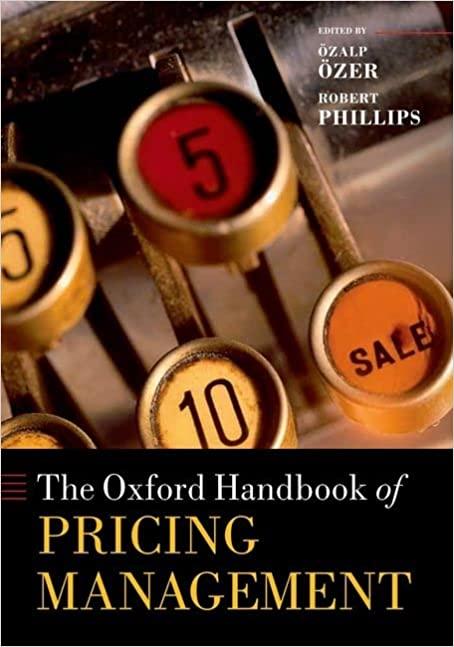Question
Apply in excel and provide formula sheet for question #4 ? You bought a Mega Millions ticket (with Megaplier) and found out that you just
Apply in excel and provide formula sheet for question #4 ?
You bought a Mega Millions ticket (with Megaplier) and found out that you just missed the jackpot by 1 number, as the second prize winner, you received $5 million. After paying taxes, buying a Maserati, a yacht, and a nice house, you are left with about $1 million. According to statistics, nearly 1/3 of lottery winners declare bankruptcy at one point in their lives, you dont want to be one of them. Now you decide that you are going to blow the rest of your money like a pro!
1. Starting now, you want to put down some money once a year for 30 years to a savings account as a raining day fund. Today you will put down the first saving: $5000, and the amount will grow at 3% every year after that. The savings account with Bank of America offers you 0.03% annual interest rate. You want to know (1) How much is your rainy day fund worth in todays dollars? (2) How much will you accumulate in your rainy day fund after 30 years? 2. Theres a piece of land (0.44 acres) for sale just off Kennedy Blvd, and you are thinking about buying the land, developing it into an office building and then selling it. The seller of the land asked for $600,000. The general contractor says that he can develop it for you and build the office in just one year. You plan to do a month-by-month capital budgeting and see if you should proceed with this investment. If you buy the land today, your cost is the price of the land plus 2% fee for titling, real estate broker, etc. Starting in month 1, your general contractor will take care of the rest, including site development and construction. He asks for $40,000 per month for everything. After 12 months, the building will be done and you will try to sell it for $2 million. You agree to pay 5% to your real estate agent when its sold. Your income tax rate is 33%. You also think the appropriate discount rate for this project is 8% annually. Now you have all the numbers in front of you, you want to (1) Decide whether you should take this investment or not. (2) Create a NPV profile (3) Do a sensitivity analysis and scenario analysis to get a better picture of the risk you are facing. (4) You might not be able to afford the cost of construction towards the end, you need to get a $100,000 loan from the bank. After talking to Fifth Third Bank, they agreed to offer you a 10-year loan of $100,000 with fixed monthly payments and floating interest rates. Your interest rates will be 3.5% for the first 2 years, 3.2% for the next 3 years, 3% for the last 2 years and 2.8% for the last 3 years. You want to create a loan amortization table to figure out what your payments look like. 3. You graduated from USF and got a job at MetLife pension department. Your supervisor needs your help with some of the funds liabilities and risk control. The pension fund has a series of liabilities to be paid every 6 months to the pension plan beneficiaries: $2,000,000, $2,200,000, $2,500,000, $3,200,000, $3,700,000, $4,300,000, $4,700,000, and $5,100,000. Your company wishes to construct a portfolio of assets to cover this series of liabilities, such that it is immunized against interest rate risk right now. The company is considering investing in four bonds: (1) a 1-year Treasury Bill with a face value of $1,000 and no coupon, (2) a 2-year Treasury note with a face value of $1,000 and an annual coupon rate of 1.5%, (3) a 3-year Treasury note with a face value of $1,000 and an annual coupon rate of 1.90%, and (4) a 4-year Treasury note with a face value of $1,000 and an annual coupon rate of 2.30%. All Treasury notes make 2 (semi-annual) coupon payments per year. The current APR yield on all bonds is 1.45%. Your boss wants you to find out how many of each of these four Treasury bonds the fund should buy in order to fully fund the liability and be immunized against interest rate risk right now?
4. After you sold the land, you plan to invest in stock market with the money you got. First, you picked a stock you are very interested in. You would like to simulate future daily prices of this stock for the next calendar year. In order to simulate prices, you need expected return and annualized volatilities, so you decide to calculate the annual expected return for this stock using CAPM, and you measure the annualized volatility using this stocks historical 1-year daily holding period returns. In the end, you will simulate the stock prices for the next year, the certain component and certain component of each price. A graph with these 3 series of prices will also be plotted.
Step by Step Solution
There are 3 Steps involved in it
Step: 1

Get Instant Access to Expert-Tailored Solutions
See step-by-step solutions with expert insights and AI powered tools for academic success
Step: 2

Step: 3

Ace Your Homework with AI
Get the answers you need in no time with our AI-driven, step-by-step assistance
Get Started


